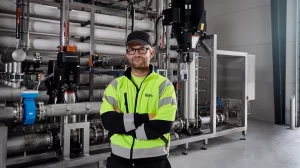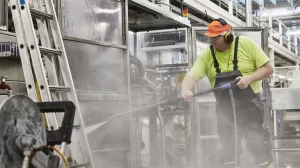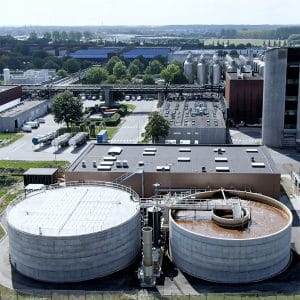Carlsberg brewery wants to cut its water use by 50% by 2030. The initiative, Zero Water Waste, is part of Carlsberg’s Together Towards Zero program. In its production facility in Fredericia, Denmark, Carlsberg has developed a Total Water Management treatment plant with consultants, universities and technology providers like Grundfos. The onsite facility treats used process water from mainly cleaning purposes, purifies it to drinking water quality and sends it back to the brewery to be reused as process water. The plant recovers and reuses 90% of its process water.

The situation
Water is an essential ingredient to produce beer. No water, no beer. Most of the water used traditionally, however, does not end up in the beer. At the Carlsberg facility in Fredericia, Denmark, around 60-65% of the total water usage goes to mainly cleaning purposes – everything from equipment, floors and surfaces to pipes and tanks to bottle and can washers and more, including cooling towers and boiler plants. This is called process water.
“Water consumption in breweries is related to the hygiene. Historically, there’s been a lot of emphasis to when you’re producing food, you need to do that with a lot of water,” says Søren Nøhr Bak, Expertise Director of Water in Food and Beverage at NIRAS, Carlsberg’s engineering consultancy partner. “Actually, going back in time, brewers would be bragging about how much water they were using, because that was an indicator of how clean it actually was. Today, that doesn’t work.”
The Carlsberg Group was using 3.4 litres of water per litre of beer produced globally in 2015, according to Tenna Skov Thorsted, Carlsberg Denmark’s Sustainability Manager.
“Our ambition is to bring it down to below 1.7,” she says, or reducing water consumption by 50% across Carlsberg Group by 2030. This ambition came from the company’s Together Towards Zero sustainability program, which calls for zero water waste by 2030, among other sustainability targets.

A dream for many years
The new plant is a result of broad collaboration in the Danish Partnership for Resource and Water-Efficient Industrial Food Production (DRIP). In DRIP, businesses, technology providers, research institutes and health and food authorities have worked to rethink how we use and reuse water and expand the limits of water purification and circularity. The Carlsberg Group, and Grundfos were part of DRIP, among many others.
Through different, small water-saving projects, Carlsberg’s Fredericia plant had already brought its own water consumption down to 2.8 litres of water per 1 litre of beer. But to get to 1.7 litres or below, it needed a bigger initiative. So in 2019 after some months of dialogues with stakeholders within the brewery, says Søren Nøhr Bak, Carlsberg decided to go big, building a demonstration facility called the Total Water Management (TWM) plant.
“Carlsberg has more than 80 breweries around the world – some of them in water-scarce areas,” Søren Nøhr Bak says. “So they wanted to make sure that they could make this work in a controlled environment so they could then take the concept and implement it in some of these other breweries.”
Carlsberg Denmark’s Brewing Director Anders Kokholm says, “This has been a dream for many years to actually do this. We had people working on this with some other companies – Grundfos included – and even tested brewing with the water, so we knew it could be done. It was just not on a big scale. So it was: Let’s do this and get it up and running.”
Onsite water reuse becomes real
“The basic idea of the project is to take all the process water and send it to a wastewater treatment plant, and then clean that water afterwards in a safe, drinking water application to make sure that we can reuse the water again within the brewery,” Kokholm says. “It will not be used as brewing water, so it will not go into the product. It will only be used for cleaning processes.”
NIRAS’s Søren Nøhr Bak says that because this had never been tried at this scale before in a Danish food and beverage company, there was a major task of winning the approval from both within Carlsberg and the Danish authorities for quality and risk assessment.
“We were out talking to all the people interested in quality,” he says. “And that’s not just the local quality organization in the brewery in Fredericia. That’s also the Group quality organization, as well as the quality organizations for Coca Cola and Schweppes, as this plant was also producing product for those franchises. Other really important parties were of course the environmental authorities and, of course, the food and beverage authorities in Denmark.”
All parties signed off, and Pantarein Water – a turnkey wastewater treatment plant provider based in Belgium – was tasked with providing the full treatment system. Grundfos would supply pumps and systems to move water and ensure precision dosing in the plant.
“Grundfos has a lot of know-how in pumps, or course,” says Bryan de Bel, Project Manager at Pantarein. “They helped us a lot during the offer phase to choose the right products for all the solutions we needed to offer. We did a lot of talking to get the most durable and efficient solutions – in consideration to both the energy consumption and sustainability. So that made a big difference for us.”
Søren Nøhr Bak adds that Grundfos was chosen because “when it came to pumping and dosing, we wanted to make sure we got very reliable solutions. Because if one of these components is failing, the whole operation will fail. Secondly, we wanted to get solutions that allowed us to monitor and control the system, so we can constantly see how we are doing within the expected benchmarks. A lot of people learned that it’s not just a pump – there’s actually an intelligence in the pump.”

The TWM plant for pure water
The TWM plant can treat 2000 cubic meters of incoming process water a day, of which 90% – or 1800 m3 – is recovered and recycled. The plant also produces biogas, which Carlsberg uses to heat its facilities, adding an extra layer of sustainability.
Anaerobic and aerobic biological treatment processes combined with MBR membrane filtration remove most of the pollutants and solids in the wastewater. The treated water is then further filtered in a closed-circuit reverse osmosis (CCRO) plant to remove dissolved salts in the water. Then the RO permeate water is “re-mineralized,” using calcium carbonate to reduce aggressiveness and ensure the water meets drinking water quality. The stabilised water than goes through a UV-light treatment. It also receives an injection of chlorine dioxide to remove bacterial risk as well as prevent potential biofilm build up in the distribution line.
Grundfos pumps help along every step of the process (see chart below or download here), says Andreas Kirketerp, Manager of the Total Water Management plant, with Grundfos covering 95% of the pumps on site.
Pantarein’s Bryan de Bel says, “As you know, chemicals are always a big risk. So for us it was very time-saving and stress-saving to get a complete dosing solution from Grundfos. We got the full cabinets with the dosing pumps, all the piping, the valves, everything was included, so we were very happy with that. In addition, the Grundfos pumps have a software with flow control. And that guarantees that you’re dosing what you need to be dosing.”
Andreas Kirketerp, Manager of the Total Water Management plant, says, “Grundfos pumps are very reliable. And this plant needs to run all the time. It’s not cheap to build a facility like this, and it needs to be able to pay itself back. It produces 1800 cubic meters a day. So if it stands still for a day, that’s 1800 cubic meters you both have to buy and also discharge to the municipality. So it needs to run. Always.”
Besides reliability, Brewing Director Anders Kokholm says the initiative came with other practical challenges that just needed time to resolve.
“One of the things that was a worry was the water coming off the plant, compared to the municipal water we were getting from the public supply. The temperature was higher,” Kokholm says. Municipal water in Denmark is around 8-9°C, whereas the TWM’s output was at 20-28°C.
The outcome
After its first half year in operation, the TWM facility has been slowly working up to capacity. Anders Kokholm calls it a gradual process.
“It’s exciting starting it up. We’re learning a lot. We switched it on in early 2021 and started to fill up the plant gradually, getting the bacteria in the wastewater treatment plant used to our wastewater,” Kokholm says. “It takes some time to build up enough sludge to handle the wastewater. So it’s a journey getting it up to full speed. We’ve seen a very positive effect in the [total water-to-brewed beer] ratio for the brewery. We are not quite at the target level yet, but we will get there in time.”
Søren Nøhr Bak says, “This is such a paradigm shift for so many people. Can you actually recycle water in a food and beverage industry? And yes, it has demonstrated it is possible to do that. We have a technology that allows us actually to safely, reliably to produce drinking water out of process effluent. It’s fantastic. This is something we can really look into implementing in all the places where we have water scarcity. All the places where we are not treating the wastewater. Think of what we can do. We can actually recycle, and we can close the circuit, making water available again.”
“For the Carlsberg group the impact is testing here and then moving into regions where we have water scarcity,” adds Anders Kokholm. “There are regions where we operate in both India and China and elsewhere where there’s not enough water. And recovering our process water in this way to make it into drinking water or similar is definitely a step forward and will get Carlsberg towards the 2030 goal.”
Carlsberg Water Reuse Facts
3.4 – Litres of water used per 1 litre of beer produced globally in 2015, on average
<1.7 – 2030 global goal in litres of water used per litre of beer produced, or a reduction of 50%, part of Carlsberg’s Together Towards Zero ambition.
65% – Amount of total water that is used as process water.
2000 m3/day – Amount of process wastewater the Total Water Management (TWM) plant can treat at a time
1800 m3/day – Amount of PURE water sent back to the factory for reuse, or 90% of the total. The remaining 10% is excess sludge and wastewater concentrate, sent to public wastewater treatment
560,000 m3 – Amount of water saved by TWM per year (or 560 million l/y)
9.6% – Reduction of energy from TWM plant’s biogas production and hot water recirculation
17 – number of Carlsberg breweries in high water risk areas globally. Carlsberg plans to use learnings from the TWM plant to reduce water waste at these sites.
Uses of process water – Cleaning vessels, tanks, pipes, machinery, surfaces, bottles and cans; also used in pasteuriser, boiler, cooling towers and more.





